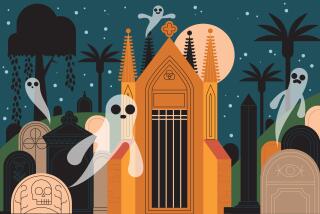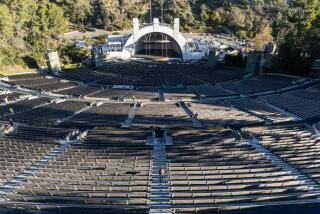ARCHITECTURE : Nature, Ersatz and the Strange Beauty of the Hollywood Bowl
- Share via
The largest piece of sculpture in Los Angeles seats 15,000 people and is usually only experienced in the dark. The Hollywood Bowl is one gorgeous curve carved out of a hill and anchored by an equally abstract, hollow object. Too bad that the history of this site is one of continual trivialization and hiding of this great gesture.
Originally, the bowl was nothing but the hillside of Bolton Canyon itself, bought by a group of civic-minded citizens to stage morally uplifting plays. Over time, these performances turned into elaborate fantasies. Temporary structures transformed the steep site into the forests of Sherwood or the Pueblos of New Mexico. Stranger and stranger fantasies emerged out of the mysteries of this isolated site.
In 1922, the new Los Angeles Philharmonic began using the sloping meadow for its summer concerts, and the site was graded for the first time.
Allied Architects, a group under the direction of Myron Hunt (designer of Pasadena City Hall), tamed the area with tiers, box seats, parking and retaining walls.
After a brief interlude during which Frank Lloyd Wright’s son, Lloyd Wright, erected a grand Mayan arch over the stage area, Allied Architect further formalized the bowl with the now-familiar set of concentric transite (a mixture of cement and asbestos) rings that act as the emanating point for the upward and outward lines of the seats.
The bowl of 1929 still held the balance between the natural shape of the hill and the attempts of humans to give shape to everything they inhabit.
Since then, artifice has taken over. Fountains and signs have proliferated, transforming the shape of the shell into an icon that spreads out through Hollywood. An electronic sign and a Works Progress Administration-era fountain guard the entrance while emulating the sweep and materials of the adjacent freeway.
Parking has crept up and around the bowl in countless terraces and ramps. An alley of concession stands has reached out to Highland Avenue in a hodgepodge of forms that mix the stone and wood of the National Park Service vernacular with the gaudy colors of the 1984 Olympics.
A parking deck has smoothed out the back of the shell and, most incongruous of all, a glass-enclosed moving sidewalk completely denies the slope of the terrain. Even the shell itself has become inhabited with acoustical bubbles designed by Frank Gehry and lighting and sound equipment that looks to have been designed by stagehands.
Concrete block gates, clipped hedges and exit signs mark out the lines of the bowl itself, whereas the sensuous forms of the canyon come together to form a massive screen that girds the whole experience.
I must confess that I find the bowl to be a beautiful but strange place, where nothing is quite real. An amplified space held together with a network of support buildings that deny the actual landscape has become a place to listen to amplified music.
Only those wealthy or old enough to command near-in box seats can allow themselves to be overwhelmed by the grandeur of the whole installation, themselves becoming figures in a Chinese puzzle seen by those in the higher tiers.
Perhaps the beauty of the bowl today lies exactly in this strange composition of isolated moments: the back of the shell, which looks like nothing so much as a giant green slug, complete with transmission tower-like antennae; the enigmatic and ivy-covered lighting pylons that rim the auditorium, or the ridge of the hill seen just over the shell, a soft fold of land crowned with a row of trees that stands out against the falling light.
On a cool summer evening, the Hollywood Bowl, lighted and filled with electronic sound washing up its carpet of listeners, becomes a surreal image, a spaceship of culture rising out of the primeval glades of Los Angeles.
More to Read
The biggest entertainment stories
Get our big stories about Hollywood, film, television, music, arts, culture and more right in your inbox as soon as they publish.
You may occasionally receive promotional content from the Los Angeles Times.










